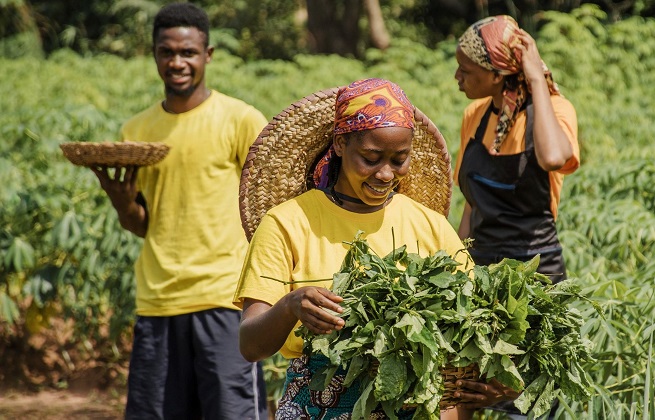Iron-Rich Foods to Add to Your Diet and Why
Chika Jones, RN, RM, RPHN, BNSC. Freelance Health Writer Reviewed by the DLHA Editorial Team

Three young African farmer carrying dark leafy vegetables rich in dietary iron. Source: Freepik
Iron is an essential mineral vital for your body and your health. [1]. Your body cannot produce iron, so it must be obtained from the foods you eat. Most times, more ironis lost from the body through blood in the stool, urine, and menstrual blood loss for girls. This is why it is important to eat iron-rich foods to replenish iron stores in the body. Reduced iron in the body leads to several symptoms, like dizziness and anemia.
This article will discuss why iron rich foods are important for your body, iron rich foods readily available across African countries and problems that could arise if iron-rich foods aren't consumed properly.
Types of Iron in Foods
There are two types of iron found in food.
Though sources of iron include red meat like beef and pork. Research shows that high consumption of red meat is linked to several types of cancers. [3]. It is vital to eat red meat in moderation.
Sources of iron-rich foods. Ai generated. from ChatGpt. Click on image to enlarge.:
Haeme Iron-rich foods
Non-Haeme Iron-rich foods
If your intake of iron-rich foods is insufficient, or you're not absorbing enough of the iron from your food, or you are losing iron from your bosy, it could cause iron deficiency and iron deficiency anemia. These two terms are often used as if they mean the same thing, but this is not so.
The symptoms are usually mild, then become severe over time. Here are some to look out for:
A condition called haemochromatosis occurs when there is excess iron absorption in the body without proper excretion of the iron. Haemochromatosis is a hereditary disease. However, it is less common among Africans. [6].
Haemochromatosis causes iron buildup over a long period. The body absorbs more iron than it needs. Haemochromatosis symptoms show around 30 - 60 years of age and may include:
Iron is stored in the liver, spleen, and bone marrow [7]. However, in haemochromatosis, excess iron is stored in the skin, heart, pancreas, and joints. This damages the organs and the body, causing complications:
Iron is a vital nutrient that plays a crucial role in maintaining good health. With its importance in transporting oxygen, regulating immune function, and supporting overall bodily functions, it's essential to consume iron-rich foods to prevent deficiency and related health issues.
By incorporating haeme and non-haeme iron sources into your diet, you can ensure adequate iron intake and reduce the risk of iron deficiency anemia.
Remember to consume red meat in moderation and pair non-haeme iron foods with vitamin C-rich foods to enhance absorption. By prioritising iron-rich foods, you can take a significant step towards maintaining optimal health and well-being.
1. Moustarah F, Mohiuddin SS. Dietary iron [Internet]. PubMed. Treasure Island (FL): StatPearls Publishing; 2024. Available from here
2. Kalman D, Hewlings S, Madelyn-Adjei A, Ebersole B. Dietary Haeme Iron: A Review of Efficacy, Safety, and Tolerability. Nutrients [Internet]. 2025;17(13):2132. Available from here
3. Hooda J, Shah A, Zhang L. Haeme, an essential Nutrient from Dietary Proteins, Critically Impacts Diverse Physiological and Pathological Processes. Nutrients [Internet]. 2014 Mar 13;6(3):1080–102. Available from here
4. Firdose K, Firdose N. Dietary Iron [Internet]. www.intechopen.com. IntechOpen; 2021. Available from here
5. Muriuki JM, Mentzer AJ, Webb EL, Morovat A, Kimita W, Ndungu FM, et al. Estimating the burden of iron deficiency among African children. BMC Medicine. 2020 Feb 27;18(1). Available from here
6. Porter JL, Rawla P. Haemochromatosis [Internet]. Nih.gov. StatPearls Publishing; 2023. Available from here
7. National Institutes of Health. Iron: Fact Sheet for Health Professionals [Internet]. National Institutes of Health. 2024. Available from here
Watch the video below to learn more about iron-rich foods and their deficiencies..
Published: August 14,2025
© 2025. Datelinehealth Africa Inc. All rights reserved.
Permission is given to copy, use, and share content freely for non-commercial purposes without alteration or modification, and subject to source attribution
DATELINEHEALTH AFRICA INC., is a digital publisher for informational and educational purposes and does not offer personal medical care and advice. If you have a medical problem needing routine or emergency attention, call your doctor or local emergency services immediately, or visit the nearest emergency room or the nearest hospital. You should consult your professional healthcare provider before starting any nutrition, diet, exercise, fitness, medical or wellness program mentioned or referenced in the DatelinehealthAfrica website. Click here for more disclaimer notice.